Understanding the Different Types of Asphalt Patching Materials

Asphalt patches are an essential aspect when it comes to the maintenance of asphalt surfaces. Patching materials are used to fill cracks, potholes, and other damage caused by weather or constant traffic. There are different types of asphalt patching materials available on the market today. However, not all patching materials are created equal. Each type of patching material has its own unique properties and benefits. In this blog post, we will be discussing the different types of asphalt patching materials, their benefits, and how they can improve your asphalt surface.
1. Cold-mix Asphalt Patching Material
Cold-mix asphalt patching material is applied to damaged asphalt surfaces without the need for heating. This type of patching material is mixed with water and applied to damaged surfaces using a shovel or trowel. It is a low-cost option for patching small areas and can be used for potholes, cracks, and small depressions.
2. Hot-mix Asphalt Patching Material
Hot-mix asphalt patching material is commonly used by professional contractors for large-scale repairs. The process involves heating the patching material to a temperature of 300°F before being applied to the damaged surface. Hot-mix asphalt provides a longer-lasting repair than cold-mix asphalt. It is also the most durable option for heavy traffic areas.
3. Rubberized Asphalt Patching Material
Rubberized asphalt patching material is a popular option for high-traffic areas such as parking lots, highways, and driveways. This type of patching material strengthens the surface and can withstand constant use without cracking. The rubberized material is made by incorporating recycled tire rubber into the asphalt mixture.
4. Infrared Asphalt Patching Material
Infrared asphalt patching material is a new technology that is quickly gaining in popularity due to its many benefits. This patching material uses infrared radiation to heat and soften the damaged asphalt surface. The softened asphalt can then be removed and replaced with new material, resulting in a seamless repair. Infrared asphalt patching is a cost-effective solution that improves the overall longevity of asphalt surfaces.
5. Polymer-modified Asphalt Patching Material
Polymer-modified asphalt patching material is a combination of asphalt and synthetic polymers. This type of patching material provides a more durable and longer-lasting repair than traditional asphalt. It is ideal for areas with high traffic and extreme weather conditions. Polymer-modified asphalt patching is more expensive than other types of patching materials but is worth the investment in the long run.
Conclusion
In conclusion, patching materials are essential in maintaining and elongating the lifespan of asphalt surfaces. Choosing the right type of patching material is crucial to ensuring proper repair and longevity. Each type of patching material has its own set of benefits and limitations, depending on the extent and type of damage. At Reliable Pavement Maintenance, we believe in providing the best possible repair solutions for our clients. If you have any questions about the different types of asphalt patching materials or need advice on which type of patching material is best for your asphalt surface, or if you're looking for asphalt services and sealcoating in Lake County, FL, contact Reliable Pavement Maintenance today to request an estimate.